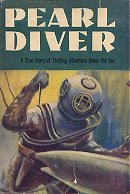
Twenty Thousand Leagues Under the Seas is a classic science fiction adventure novel by French writer Jules Verne.
The timeline of underwater diving technology is a chronological list of notable events in the history of the development of underwater diving equipment. With the partial exception of breath-hold diving, the development of underwater diving capacity, scope, and popularity, has been closely linked to available technology, and the physiological constraints of the underwater environment.
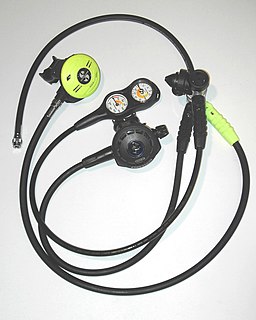
A diving regulator is a pressure regulator that controls the pressure of breathing gas for diving. The most commonly recognised application is to reduce pressurized breathing gas to ambient pressure and deliver it to the diver, but there are also other types of gas pressure regulator used for diving applications. The gas may be air or one of a variety of specially blended breathing gases. The gas may be supplied from a scuba cylinder carried by the diver or via a hose from a compressor or high-pressure storage cylinders at the surface in surface-supplied diving. A gas pressure regulator has one or more valves in series which reduce pressure from the source, and use the downstream pressure as feedback to control the delivered pressure, or the upstream pressure as feedback to prevent excessive flow rates, lowering the pressure at each stage.
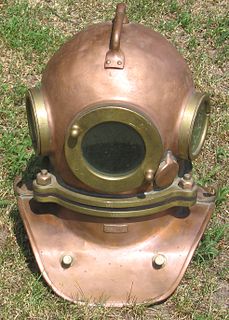
A diving helmet is a rigid head enclosure with a breathing gas supply used in underwater diving. They are worn mainly by professional divers engaged in surface-supplied diving, though some models can be used with scuba equipment. The upper part of the helmet, known colloquially as the hat or bonnet, may be sealed directly to the diver using a neck dam, connected to a diving suit by a lower part, known as a breastplate, or corselet, depending on regional language preferences. or simply rest on the diver's shoulders, with an open bottom, for shallow water use.

Scuba diving is a mode of underwater diving whereby divers use breathing equipment that is completely independent of a surface air supply. The name "scuba", an acronym for "Self-Contained Underwater Breathing Apparatus", was coined by Christian J. Lambertsen in a patent submitted in 1952. Scuba divers carry their own source of breathing gas, usually compressed air, affording them greater independence and movement than surface-supplied divers, and more time underwater than free divers. Although the use of compressed air is common, a gas blend with a higher oxygen content, known as enriched air or nitrox, has become popular due to the reduced nitrogen intake during long and/or repetitive dives. Also, breathing gas diluted with helium may be used to reduce the likelihood and effects of nitrogen narcosis during deeper dives.

Pearl hunting, also known as pearling, is the activity of recovering pearls from wild molluscs, usually oysters or mussels, in the sea or freshwater. Pearl hunting was prevalent in the arabian Gulf region and Japan for thousands of years. On the northern and north-western coast of Western Australia pearl diving began in the 1850s, and started in the Torres Strait Islands in the 1860s, where the term also covers diving for nacre or mother of pearl found in what were known as pearl shells.
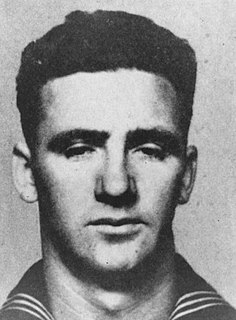
Owen Francis Patrick Hammerberg was a United States Navy diver who received the Medal of Honor posthumously for rescuing two fellow divers.
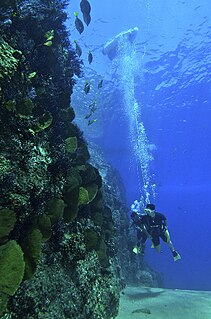
Snuba is form of surface-supplied diving that uses an underwater breathing system developed by Snuba International. The origin of the word "Snuba" may be a portmanteau of "snorkel" and "scuba", as it bridges the gap between the two. Alternatively, some have identified the term as an acronym for "Surface Nexus Underwater Breathing Apparatus", though this may have been ascribed retroactively to fit the portmanteau. The swimmer uses swimfins, a diving mask, weights, and diving regulator as in scuba diving. Instead of coming from tanks strapped to the diver's back, air is supplied from long hoses connected to compressed air cylinders contained in a specially designed flotation device at the surface. Snuba often serves as a form of introductory diving, in the presence of a professionally trained guide, but requires no scuba certification.
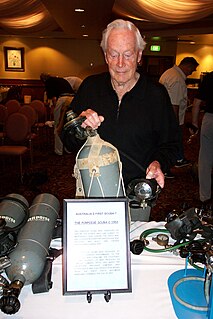
Edward Francis Eldred was a pioneer of scuba diving in Australia. He invented Porpoise scuba gear.
Albert Alvin Tillman was an American educator and underwater diver.

Yves Paul Gaston Le Prieur was an officer of the French Navy and an inventor.
DESCO is an underwater diving equipment maker which was first organized in 1937 in Milwaukee, Wisconsin as Diving Equipment and Salvage Co.
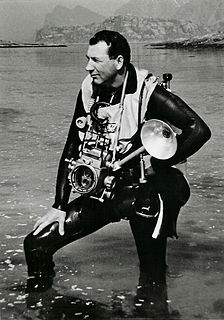
Vintage scuba is scuba equipment dating from 1975 and earlier, and the practice of diving using such equipment.
John D. Craig (1903–1997) was an American businessman, writer, soldier, diver, Hollywood stunt man, film producer, and television host. He worked in the commercial surface-supplied diving industry from the 1930s on, and filmed aerial combat over Europe during World War II. He is best known for using film and television to show the United States public the beauties and dangers of Earth's underwater worlds.
Maurice Fernez was a French inventor and pioneer in the field of underwater breathing apparatus, respirators and gas masks. He was pivotal in the transition of diving from the tethered diving helmet and suit of the nineteenth century to the free diving with self-contained equipment of the twentieth century. All Fernez invented apparatus were surface-supplied but his inventions, especially his mouthpiece equipped with a one-way valve, inspired the scuba diving pioneer Yves le Prieur. He was also a talented businessman who created a company to manufacture and sell the breathing apparatus he invented, and expanded its range of products to include gas masks, respirators and filters.
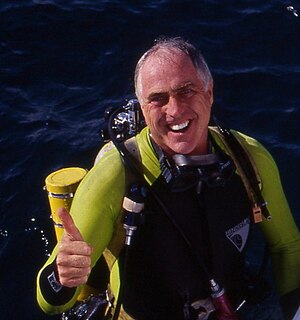
Bob Halstead, has made significant contributions to the sport of scuba diving in a multitude of capacities: photographer, author of eight diving books, early innovator in the development of dive tourism, pioneer in the dive liveaboard industry, diving instructor and educator, marine-life explorer and influential diving industry commentator. An ardent diver since 1968, Halstead has over 10,000 logged dives.

The history of underwater diving starts with freediving as a widespread means of hunting and gathering, both for food and other valuable resources such as pearls and coral, By classical Greek and Roman times commercial applications such as sponge diving and marine salvage were established, Military diving also has a long history, going back at least as far as the Peloponnesian War, with recreational and sporting applications being a recent development. Technological development in ambient pressure diving started with stone weights (skandalopetra) for fast descent. In the 16th and 17th centuries diving bells became functionally useful when a renewable supply of air could be provided to the diver at depth, and progressed to surface supplied diving helmets—in effect miniature diving bells covering the diver's head and supplied with compressed air by manually operated pumps—which were improved by attaching a waterproof suit to the helmet and in the early 19th century became the standard diving dress.

The following outline is provided as an overview of and topical guide to underwater diving:

The following index is provided as an overview of and topical guide to underwater divers:

This is a list of underwater divers whose exploits have made them notable. Underwater divers are people who take part in underwater diving activities – Underwater diving is practiced as part of an occupation, or for recreation, where the practitioner submerges below the surface of the water or other liquid for a period which may range between seconds to order of a day at a time, either exposed to the ambient pressure or isolated by a pressure resistant suit, to interact with the underwater environment for pleasure, competitive sport, or as a means to reach a work site for profit or in the pursuit of knowledge, and may use no equipment at all, or a wide range of equipment which may include breathing apparatus, environmental protective clothing, aids to vision, communication, propulsion, maneuverability, buoyancy and safety equipment, and tools for the task at hand.
